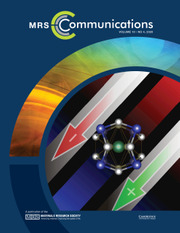Crossref Citations
This article has been cited by the following publications. This list is generated based on data provided by
Crossref.
Li, Xiao
Wang, Jing
Liu, Jin
Tang, Jianguo
Wang, Jing
Guo, Junlan
Wang, Yao
Huang, Linjun
Aleem, Abdur Raheem
Kipper, Matthew J.
and
Belfiore, L. A.
2019.
Strong luminescence and sharp heavy metal ion sensitivity of water-soluble hybrid polysaccharide nanoparticles with Eu3+ and Tb3+ inclusions.
Applied Nanoscience,
Vol. 9,
Issue. 8,
p.
1833.
Li, Zhenhua
Sun, Guotao
Snow, Christopher D.
Xu, Yanan
Wang, Yao
Xiu, Dan
Zhang, Yu
Zhu, Zhijun
Belfiore, Laurence A.
and
Tang, Jianguo
2020.
Near infrared emitting and biocompatible Yb3+-DNA complexes with dual responses to Cu2+ and Fe3+.
Optical Materials,
Vol. 108,
Issue. ,
p.
110157.
Wang, Jing
Wang, Jing
Liu, Jin
Wang, Xinzhi
Aleem, Abdur Raheem
Song, Zhengxing
Kipper, Matt J.
and
Tang, Jianguo
2020.
Smart sensing of bacterial contamination on fluorescent cotton fabrics (FCF) by nontoxic Eu3+-induced polyelectrolyte nano-aggregates (EIPAs).
Dyes and Pigments,
Vol. 181,
Issue. ,
p.
108536.
Wang, Jing
Liu, Jin
Wang, Jing
Wang, Yao
Cao, Jie
Hou, Lin
Ge, Ruifen
Chi, Jinnan
Huang, Linjun
Guo, Junlan
Aleem, Abdur Raheem
Song, Zhengxing
Tamang, Shree Krishna
Liu, Jixian
Wang, Guanghui
Kipper, Matt J.
Belfiore, Laurence A.
and
Tang, Jianguo
2020.
Smart sensing of Cu2+ in living cells by water-soluble and nontoxic Tb3+/Eu3+-induced aggregates of polysaccharides through fluorescence imaging.
Journal of Materials Chemistry C,
Vol. 8,
Issue. 24,
p.
8171.
Shen, Wenfei
Zhao, Guoqing
Zhang, Xiaolin
Bu, Fanchen
Yun, Jungheum
and
Tang, Jianguo
2020.
Using Dual Microresonant Cavity and Plasmonic Effects to Enhance the Photovoltaic Efficiency of Flexible Polymer Solar Cells.
Nanomaterials,
Vol. 10,
Issue. 5,
p.
944.
Sun, Yingjian
Li, Qingfeng
Wei, Shuai
Zhao, Ruichun
Han, Jingfen
and
Ping, Guichen
2020.
Preparation and luminescence performance of flexible films based on curdlan derivatives and europium (III) complexes as luminescent sensor for base/acid vapor.
Journal of Luminescence,
Vol. 225,
Issue. ,
p.
117241.
Podyachev, Sergey N.
Zairov, Rustem R.
and
Mustafina, Asiya R.
2021.
1,3-Diketone Calix[4]arene Derivatives—A New Type of Versatile Ligands for Metal Complexes and Nanoparticles.
Molecules,
Vol. 26,
Issue. 5,
p.
1214.
Wang, Jing
Wang, Tao
Hu, Yimeng
Zhang, Xiaonan
Ma, Yanyan
Lv, Hongmin
Xu, Shanshan
Wang, Yinglong
and
Jiang, Zike
2021.
Fe3+ sensitivity fluorescence sensor from β-cyclodextrin-enhanced Eu3+ luminescence aggregates.
Journal of Materials Science,
Vol. 56,
Issue. 18,
p.
10979.
Wang, Xiaozhen
Wang, Yanxin
Huang, Linjun
Li, Bingyang
Yan, Xianhang
Huang, Zhenzhen
Wang, Yao
Kipper, Matt J.
and
Tang, Jianguo
2021.
Sensitive Cu2+ detection by reversible on-off fluorescence using Eu3+ complexes in SiO2, in chitosan/polyethylene oxide nanofibers.
Materials & Design,
Vol. 205,
Issue. ,
p.
109708.
Aleem, Abdur Raheem
Ding, Wei
Liu, Jin
Li, Taisen
Guo, Yaowei
Wang, Qian
Wang, Yao
Wang, Yanxin
Rehman, Faisal U.L.
Kipper, Matt J.
Belfiore, Laurence A.
and
Tang, Jianguo
2021.
Visible-light excitable Eu3+-induced hyaluronic acid-chitosan aggregates with heterocyclic ligands for sensitive and fast recognition of hazardous ions.
International Journal of Biological Macromolecules,
Vol. 184,
Issue. ,
p.
188.
Song, Zhengxing
Wang, Jing
Wang, Jing
Liu, Jin
Wang, Xinzhi
Wang, Yao
Aleem, Abdur Raheem
Kipper, Matt J.
Belfiore, Laurence A.
and
Tang, Jianguo
2021.
Eu3+-induced polysaccharide nano-dumbbell aggregates (PNDA) as drug carriers to smartly report drug concentration through variable fluorescence.
Sensors and Actuators B: Chemical,
Vol. 336,
Issue. ,
p.
129724.
Li, Taisen
Liu, Jin
Wang, Xinzhi
Aleem, Abdur Raheem
Wang, Yao
Kipper, Matt J.
Belfiore, Laurence A.
and
Tang, Jianguo
2021.
Nontoxic Gd3+ and Tb3+ co-induced polyelectrolyte nano-aggregates (GTIPAs) for luminescence/magnetic resonance dual-modality imaging.
Optical Materials Express,
Vol. 11,
Issue. 9,
p.
2828.
Li, Cuicui
Tang, Qinglin
Wei, Heng
Liu, Jin
Wang, Qian
Wang, Yao
Du, Zhonglin
Wang, Jiuxing
Xu, Rui
Bi, Yupeng
Snow, Christopher D.
Belfiore, Laurence A.
and
Tang, Jianguo
2022.
Smart Wearable Fluorescence Sensing of Bacterial Pathogens and Toxic Contaminants by Eu3+-Induced Sodium Alginate/Ag Nanoparticle Aggregates.
ACS Applied Nano Materials,
Vol. 5,
Issue. 6,
p.
8393.
Novo, Diana C.
and
Edgar, Kevin J.
2024.
Smart fluorescent polysaccharides: Recent developments and applications.
Carbohydrate Polymers,
Vol. 324,
Issue. ,
p.
121471.




